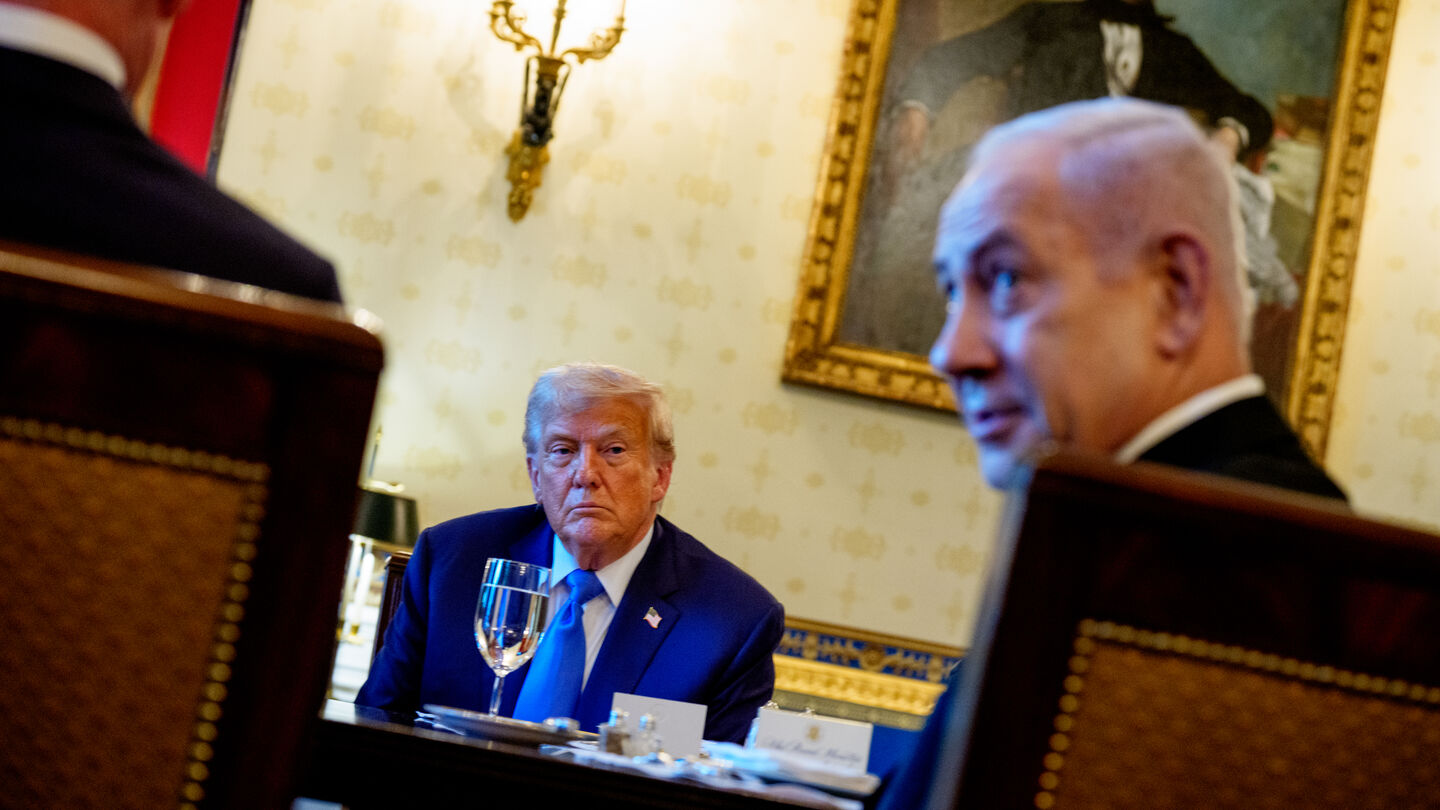US, Israel leave open future strikes amid questions over Iran's nuclear sites
Welcome back to Al-Monitor Security.
The Trump administration appears eager to turn a new page in the US’ four-decade-long covert conflict with Iran.
But as US and Iranian officials are expected to return to the negotiating table, new questions are being raised about the effectiveness of the US long-range bombing campaign targeting Iran’s nuclear facilities.
Could the uncertainty about the damage give Iranian negotiators an edge?
Israeli Prime Minister Benjamin Netanyahu visited Washington this week in a bid to up the ante.
That and more this week. Thanks for reading.
Jared Szuba
@jm_szuba

Leading this week

Israeli Prime Minister Benjamin Netanyahu, accompanied by U.S. President Donald Trump (L), speaks during a dinner in the Blue Room of the White House on July 07, 2025 in Washington, DC. Trump is hosting Netanyahu to discuss a potential ceasefire agreement to end the fighting in Gaza. (Photo by Andrew Harnik/Getty Images) — Andrew Harnik/Getty Images
With a resumption of US-Iran negotiations over Tehran's nuclear program said to be on the horizon, neither the United States nor Israel has ruled out resorting to military force again against Iran if deemed necessary.
Iranian officials have acknowledged their key nuclear facilities sustained extensive damage in last month's 12-day war, and there is little doubt that Iran's negotiating position has been seriously weakened. But two new details emerged this week from preliminary US and Israeli assessments, which, if borne out, could suggest Tehran may not be approaching the talks bereft of all leverage.
Prime Minister Benjamin Netanyahu arrived in Washington earlier this week seeking Trump’s blessing to resume military strikes in Iran should Israeli intelligence determine the Iranians are attempting to resurrect their nuclear program.
If Netanyahu was seeking a public endorsement from Trump for Israeli jets to reopen a shooting gallery in Iranian airspace, he didn't get it.
Ball in Iran's court
It remains unknown what agreements, if any, were struck between the two regarding plans for further military action. The prime minister landed back in Israel on Friday after four days in Washington.
During a meeting with US Defense Secretary Pete Hegseth and other top US military officials at the Pentagon on Tuesday, Netanyahu declined to answer when asked by Al-Monitor whether Iran’s nuclear and conventional threats had been defeated.
One of the ostensible goals of Netanyahu’s visit was to raise the ante ahead of an anticipated new round of indirect negotiations between American and Iranian officials.
The three sides are holding their cards close ahead of the expected talks, a date for which has not yet been publicly confirmed. Neither the Trump administration nor Masoud Pezeshkian’s government has budged on their publicly stated red lines about whether Iran will be permitted to domestically enrich uranium.
(Iran's UN ambassador told Al-Monitor last month that his government would continue to enrich uranium domestically but would be willing to have 20% and 60% enriched uranium stockpiles offshored in return for receiving yellowcake).
Regardless of whether Iranian engineers can recover key components of its nuclear program from beneath the rubble, the IRGC still possesses a formidable arsenal of conventional ballistic missiles that has survived the 12-day offensive by Israel.
“They possess considerable tactical capability,” the no.-2 top commander of US forces in the Middle East, Vice Adm. Brad Cooper, told Senate lawmakers last month.
Trump has repeatedly threatened to authorize additional US strikes on Iran should diplomacy fail to formally end its uranium enrichment efforts.

Infographic with satellite image from Planet Labs PBC from June 22, 2025, showing visible damages from US strike on the Natanz uranium enrichment plant in Iran. — GUILLERMO RIVAS PACHECO, JULIE PEREIRA/AFP via Getty Images
Compound uncertainty
On Thursday, a senior US defense official acknowledged to reporters that the Pentagon agency that designed the massive bunker-busting GBU-57 bombs dropped by the US Air Force onto Iran’s Fordow nuclear site last month does not know whether any of the 12 munitions penetrated into the actual enrichment facility some 300 feet below the surface.
An initial assessment by US intelligence concluded that all of the 30,000-pound GBU-57 MOP bombs dropped by the B-2s precisely targeted two ventilation shafts above the underground facility as intended. But senior officials said the Pentagon’s Defense Threat Reduction Agency could not confirm how deeply the bombs penetrated into the mountain at Fordow.
"That is a level of detail that we don't have access to at this point in time," said one of the officials, who spoke to reporters on condition of anonymity.
Meanwhile, a senior Israeli official speaking to a group of reporters in Washington on Thursday said that some of the highly enriched uranium at sites like Fordow may be intact and recoverable by Iranian engineers.
The new acknowledgements cast further doubt on how completely Iran's highly enriched uranium stockpiles have been destroyed, raising new questions about Iran's next steps.
Another senior US military official speaking to reporters on the same call on Thursday underscored that the objective of the strikes was to “diminish the capability of the Iranian nuclear program.”
The Pentagon thus far estimates the combined US naval and air strikes on Iran's Fordow, Natanz and Isfahan facilities have set back the Islamic Republic's nuclear program close to two years.
"The only way they know apart from overhead [imaging] is computer modeling," a former senior US official familiar with the operational planning told Al-Monitor Security.
Moment of truth
Israeli leaders began setting into motion plans to strike Iran’s nuclear facilities with or without US support after picking up intelligence late last year that they interpreted as indicating Iranian personnel were taking new steps toward nuclear weaponization, the Israeli official told reporters on Thursday.
Evidence of the Iranian activity was detected after Israel’s surprise assassination of Hezbollah's powerful leader Hassan Nasrallah in September 2023, the official said.
That intelligence, some of which was based on signals intercepts, raised doubts among some US officials about the Israelis’ interpretations, according to two other people briefed on the material.
The surprise killing of the influential militia leader dealt a devastating blow to Iran's western deterrence bulwark fronted by Hezbollah, which largely collapsed as a fighting force in the wake of Israel's offensive in Lebanon.
Yet Israeli officials thus far seem unfazed by the prospect that there may be surviving 60% enriched uranium stockpiles in Iran, according to the New York Times. Any activity by Iranian engineers to recover the material from beneath the rubble would be relatively easy to detect, the Israeli official told the Times and other outlets.

In other news
PA steps up. The Palestinian Authority is ready to cooperate with the Trump administration on steps toward statehood, and the PLO is willing to take over full control of the Gaza Strip once a permanent ceasefire is reached, Palestinian Foreign Minister Varsen Aghabekian told Al-Monitor’s Daoud Kuttab in an exclusive interview.
Yet Israeli Prime Minister Benjamin Netanyahu hasn’t budged — at least publicly — from his decades-long opposition to the prospect of Palestinian self-determination.
“Overall security will always remain in our hands,” Netanyahu said alongside Trump at the White House on Tuesday evening. “We’ll work out a peace with our Palestinian neighbors — those who don’t want to destroy us,” he caveated.
“Now, people will say, 'It’s not a complete state; it’s not a state.' We don’t care.”
Israel’s sweepingly successful strikes against Iran’s military leadership have buoyed Netanyahu’s domestic political popularity, raising brief speculation that he may be able to ditch his extreme-right coalition partners and concede on his resistance to a future PA role in Gaza. So far that hasn’t happened.
What we’re reading
- Ahmed al-Sharaa’s government in Damascus has refused to delineate territorial autonomy for Syria’s Kurds, fearing the need to make similar concessions for Alawites and Druze. Meanwhile, Washington’s patience is wearing thin as American troops slowly reduce their footprint in the Kurdish-dominated northeast, Al-Monitor’s chief correspondent, Amberin Zaman, reports.
- Al-Monitor’s correspondent in Tehran weighs whether Russia and China can resupply Iran with sufficient air defense deterrents to ward off future Israeli strikes.
Quotable
“Hezbollah needs to see that there’s a future for them, that that road is not harnessed just solely against them and that there’s an intersection of peace and prosperity for them also.”
— US Ambassador to Turkey Tom Barrack, speaking to reporters in Baabda, Lebanon, after meeting with President Joseph Aoun.

In case you missed it
US strikes on Iran included F-22s, F-35s, Hegseth says — (Al-Monitor)
US envoy warns Lebanon will be ‘left behind’ without action on Hezbollah — (Al-Monitor)
Houthis resume attacks on Red Sea shipping — (Al-Monitor)
Turkey gives drought-stricken Iraq more water in boost to PM Sudani — (Al-Monitor)
A defiant Iran draws on the lessons of an earlier war — (Wall Street Journal)
Turkey’s spy chief heads to Iraq as PKK militants prepare to disarm – (Al-Monitor)
